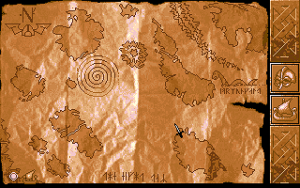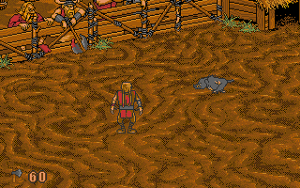Heimdall
The earliest games on the Stack, the ones from the 1980s and early 90s, are all RPGs. You might think this means that I’m a big RPG fan, but only if you forget the reason that these games are still on the Stack after all these years: they’re the ones that I haven’t played yet. They’re also not games that I purchased when they were new. Everything I’ve played so far in this chronological run-through has been from various anthology packages, all released around 1998. I’d say Heimdall doesn’t quite qualify as part of this trend, but it’s a judgment call: I bought it, on impulse, as part of a 1995 bargain-bin two-pack re-release that included its sequel, Heimdall II.
I understand Heimdall to be a fairly short game, but I was unable to complete it back when I bought it because the graphical effects accompanying spellcasting caused my system to crash. We’ll see if DOSBox does any better. I have reason to be worried already, though: even before I get into the game proper, I’m getting graphical glitches. If I play in fullscreen mode, sometimes it gets into this state where graphics simply don’t show up until the part of the screen they’re on changes. Animation shows, and the non-animated bits of the screen can be revealed by scrubbing over them with the cursor, which could make an interesting game element if it were deliberate, but it’s not. At any rate, it doesn’t seem to happen when run the game in a window, so that’s how I’m going forward. We’ll see if this prevents the game-crashing later on.
I suppose I’ve been fortunate to have had so little trouble with other games this year. I remember the DOS days as being full of game-specific tweaking — editing the config.sys file to free up more EMS memory, fiddling with IRQs, etc. DOSBox takes care of a lot of that automatically, of course, but also, I think we’re just hitting the point in the history of PC games where compatibility problems started hitting hard, thanks to the slow adoption of VGA, the variety of new sound cards, and the increasing demands on memory of both the games and the hardware drivers. Windows 95 and DirectX would simplify things a lot, but that’s still a few years off at this point. (And also, the era of DOS games didn’t exactly end immediately.)
 So, about the game. This is basically an action-puzzle-RPG about vikings. Cartoonish ones. Not nearly as cartoonish as the ones in The Lost Vikings, but definitely moreso than those in Rune. But unlike most games about vikings, it puts a certain amount of emphasis on the fact that vikings are sailors. The main navigation mode is all about sailing from island to island, and your party can contain characters of classes like “shipwright” and “navigator”. Functionally, however, they all seem to just occupy various spots on the scale from warrior to wizard. I’m just getting started here, so it’s possible that the nominal professions will become important later, but there’s no indication of it in the docs. (Also, the fact that all characters, regardless of profession, are represented in the landing party by either a warrior figure or a wizard figure is a little suspicious.)
So, about the game. This is basically an action-puzzle-RPG about vikings. Cartoonish ones. Not nearly as cartoonish as the ones in The Lost Vikings, but definitely moreso than those in Rune. But unlike most games about vikings, it puts a certain amount of emphasis on the fact that vikings are sailors. The main navigation mode is all about sailing from island to island, and your party can contain characters of classes like “shipwright” and “navigator”. Functionally, however, they all seem to just occupy various spots on the scale from warrior to wizard. I’m just getting started here, so it’s possible that the nominal professions will become important later, but there’s no indication of it in the docs. (Also, the fact that all characters, regardless of profession, are represented in the landing party by either a warrior figure or a wizard figure is a little suspicious.)
 The initial character creation stage — which only creates the stats for the main hero, not for the rest of the crew (at least not directly) — is particularly notable. In it, you prove your worth for the coming adventure by means of three minigames: throwing axes, fighting on a boat, and catching a greased pig. The notable thing about it is how much programming time must have gone into such a minor part of the game: each of the minigames uses its own mechanics and user interface, takes about a minute to finish, and, as far as I can tell, is used nowhere else in the game. You see it only once unless you start over — which I suppose most players will do, because you’re bound to be disappointed in your first try. But to make the whole thing even more marginal, it’s skippable. You can go directly into the main game with less-than-ideal stats if you want to. For a while, I thought I was going to have to do this, because I thought that the game had frozen up at the start of the greased pig sequence, but when I consulted the manual, it turned out that I had to press the space bar to make it start. (I think I tried every other plausible keystroke.) I’m glad I didn’t have to skip it after all, because in addition to your stats, the minigames also govern who you can put on your crew: there’s a choice of 30 characters, but the more powerful ones turn up their noses at sailing under viking who can’t even catch a pig.
The initial character creation stage — which only creates the stats for the main hero, not for the rest of the crew (at least not directly) — is particularly notable. In it, you prove your worth for the coming adventure by means of three minigames: throwing axes, fighting on a boat, and catching a greased pig. The notable thing about it is how much programming time must have gone into such a minor part of the game: each of the minigames uses its own mechanics and user interface, takes about a minute to finish, and, as far as I can tell, is used nowhere else in the game. You see it only once unless you start over — which I suppose most players will do, because you’re bound to be disappointed in your first try. But to make the whole thing even more marginal, it’s skippable. You can go directly into the main game with less-than-ideal stats if you want to. For a while, I thought I was going to have to do this, because I thought that the game had frozen up at the start of the greased pig sequence, but when I consulted the manual, it turned out that I had to press the space bar to make it start. (I think I tried every other plausible keystroke.) I’m glad I didn’t have to skip it after all, because in addition to your stats, the minigames also govern who you can put on your crew: there’s a choice of 30 characters, but the more powerful ones turn up their noses at sailing under viking who can’t even catch a pig.
Next time I’ll try to describe the main part of the game a little. I’m still getting used to how it all works.
 Comments(0)
Comments(0)